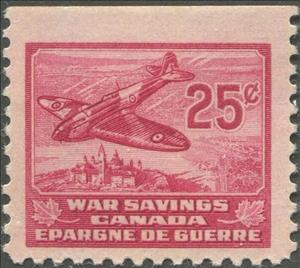Stamp: Spitfire (Canada 1940)
Spitfire (Canada 1940)
01 January (Canada ) within release War Savings goes into circulation Stamp Spitfire face value 25 Canadian cent
| Stamp Spitfire in catalogues | |
|---|---|
| Colnect codes: | Col: CA WS1940-02 |
Stamp is square format.
Van Dam Revenue Catalog #FWS6Also in the issue War Savings:
- Stamp - Anti-aircraft gun face value 25;
- Stamp - Bomber face value 25;
- Stamp - Destroyer face value 25;
- Stamp - Numeral face value 25;
- Stamp - Nurses face value 25;
- Stamp - Pilots face value 25;
- Stamp - Sailor face value 25;
- Stamp - Soldier face value 25;
- Stamp - Spitfire face value 25;
- Stamp - Tank face value 25;
- Booklet Pane - War Savings - booklet pane face value 8*25;
- Booklet - Canada War Savings Stamps face value 10;
- Booklet - Canada War Savings Stamps face value 10;
- Booklet - Canada War Savings Stamps face value 10;
- Stamp - Numeral face value 25;
- Booklet Pane - Numeral face value 8*25;
- Booklet Pane - Spitfire face value 8*25;
|
Data entry completed
50%
|
|
|---|---|
| Stamp Spitfire in digits | |
| Country: | Canada |
| Date: | 1940-01-01 |
| Emission: | Savings Stamps |
| Format: | Stamp |
| Face Value: | 25 Canadian cent |
Stamp Spitfire it reflects the thematic directions:
An air force, also known in some countries as an aerospace force or air army, is in the broadest sense, the national military branch that primarily conducts aerial warfare. More specifically, it is the branch of a nation's armed services that is responsible for aerial warfare as distinct from an army, navy, or a marine corps. Typically, air forces are responsible for gaining control of the air, carrying out strategic and tactical bombing missions, and providing support to land and naval forces.
The term "air force" may also refer to a tactical air force or numbered air force, which is an operational formation either within a national air force or comprising several air components from allied nations. Air forces typically consist of a combination of fighters, bombers, helicopters, transport planes and other aircraft.
Many air forces are also responsible for operations of the military space, intercontinental ballistic missiles (ICBM), and communications equipment. Some air forces may command and control other air defence assets such as anti-aircraft artillery, surface-to-air missiles, or anti-ballistic missile warning networks and defensive systems. Some nations, principally Russia, the former Soviet Union and countries who modelled their militaries along Soviet lines, have or had an air defence force which is organizationally separate from their air force.
Peace-time/non-wartime activities of air forces may include air policing and air-sea rescue.
Air forces are not just composed of pilots, but also rely on a significant amount of support from other personnel to operate. Logistics, security, intelligence, special operations, cyber space support, maintenance, weapons loaders, and many other specialties are required by all air forces.
An aircraft (pl. aircraft) is a vehicle that is able to fly by gaining support from the air. It counters the force of gravity by using either static lift or the dynamic lift of an airfoil, or, in a few cases, direct downward thrust from its engines. Common examples of aircraft include airplanes, rotorcraft (including helicopters), airships (including blimps), gliders, paramotors, and hot air balloons.Part 1 (Definitions and Abbreviations) of Subchapter A of Chapter I of Title 14 of the U. S. Code of Federal Regulations states that aircraft "means a device that is used or intended to be used for flight in the air."
Aviation is the practical aspect or art of aeronautics, being the design, development, production, operation and use of aircraft, especially heavier than air aircraft. The word aviation was coined by French writer and former naval officer Gabriel La Landelle in 1863, from the verb avier (synonymous flying), itself derived from the Latin word avis ("bird") and the suffix -ation.
A building or edifice is a structure with a roof and walls standing more or less permanently in one place, such as a house or factory. Buildings come in a variety of sizes, shapes and functions, and have been adapted throughout history for a wide number of factors, from building materials available, to weather conditions, to land prices, ground conditions, specific uses and aesthetic reasons. Buildings serve several needs of society – primarily as shelter from weather, security, living space, privacy, to store belongings, and to comfortably live and work. A building as a shelter represents a physical division of the human habitat (a place of comfort and safety) and the outside (a place that at times may be harsh and harmful).
A military, also known collectively as an armed forces, are a heavily armed, highly organized force primarily intended for warfare. Militaries are typically authorized and maintained by a sovereign state, with their members identifiable by a distinct military uniform. They may consist of one or more military branches such as an army, navy, air force, space force, marines, or coast guard. The main task of a military is usually defined as defence of their state and its interests against external armed threats.





